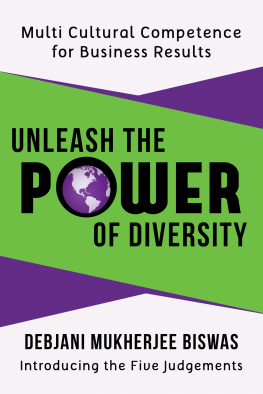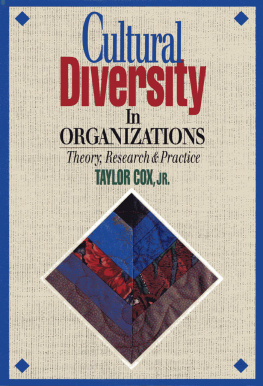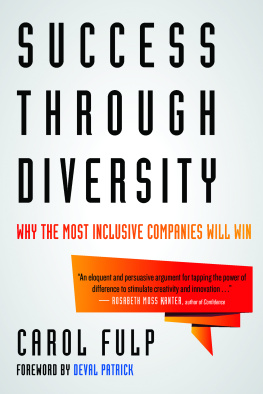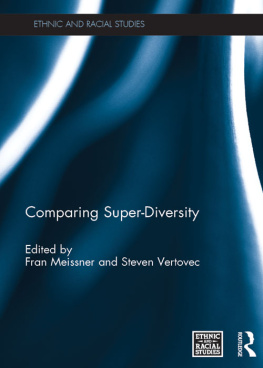The Diversity Machine
The Diversity Machine
The Drive to Change the White Male Workplace
With a new preface by the author
Frederick R. Lynch
Originally published in 1997 by The Free Press
Published 2002 by Transaction Publishers
Published 2017 by Routledge
2 Park Square, Milton Park, Abingdon, Oxon OX14 4RN
711 Third Avenue, New York, NY 10017, USA
Routledge is an imprint of the Taylor & Francis Group, an informa business
The author acknowledges with thanks, permission to reprint material from the following sources: Lewis Griggs, Valuing Diversity (videotape series), Griggs Productions, San Francisco; George F. Simons, Diversophy (game cards), 1995 Multus Inc., all rights reserved; Sondra Thiederman, Cultural Diversity Quiz: Hows Your Cultural I.Q. ? in Profiting in Americas Multicultural Marketplace: How to Do Business Across Cultural Lines, copyright 1991 Sondra Thiederman, all rights resrved [first published by Lexington Booksall correspondence should be sent to Jossey-Bass Inc., Publishers, San Francisco]; R. Roosevelt Thomas, Jr., From Affirmative Action to Affirming Diversity; R. Roosevelt Thomas, Jr., Beyond Race and Gender: Unleashing the Power of Your Total Workforce by Managing Diversity.
All rights reserved. No part of this book may be reprinted or reproduced or utilised in any form or by any electronic, mechanical, or other means, now known or hereafter invented, including photocopying and recording, or in any information storage or retrieval system, without permission in writing from the publishers.
Notice:
Product or corporate names may be trademarks or registered trademarks, and are used only for identification and explanation without intent to infringe.
Library of Congress Catalog Number: 00-062923
Lynch, Frederick R.
The diversity machine : the drive to change the white male workplace/ Frederick
R. Lynch ; with a new preface by the author.
p. cm.
Includes bibliographical references and index.
ISBN 0-7658-0731-9 (pbk.: alk. paper)
1. Diversity in the workplaceUnited States. I. Title.
HF5549.5.M5 L96 2000
331.13'3'0973dc21
00-062923
ISBN 13: 978-0-7658-0731-1 (pbk)
For my sister. Peg
And the memory of Mother and Dad
Acknowledgments
This book could not have been written without the support of the Boards of Trustees of the Sarah Scaife Foundation and the Carthage Foundation. Special thanks are due to Richard Larry, president and treasurer, respectively, of those foundations. Claremont McKenna College (CMC) president Jack Stark and two faculty deans, Ralph Rossum and Tony Fucaloro, also proved to be fearless champions of academic freedom. They sheltered a maverick sociologist in a first-rate teaching and research environment. The John Olin Foundation provided crucial support. A summer fellowship from the Benjamin Z. Gould Center sustained much rewriting, as did summer research grants from the Office of the Dean of Faculty.
CMC colleagues Jack Pitney, Joe Cardoza, Riccardo Quinoncs, Langdon Ellsbree, Steve Davis, Bob Faggen, and Judith Merkle always provided lively exchanges on this topic. Forbes magazine senior editor Peter Brimelow gave my research and spirits an early and vital boost.
Free Press senior editor Adam Bellow took a chance on a controversial author and topic. My editor at Free Press, David Bernstein, and my copy editor, Beverly Miller, were tirelessand above all patientin rereading and continually providing valuable insight and feedback. My agents, Laurie Fox and Linda Chester, listened and listened to my prepublication ramblings. Monica Morris gave feedback on a first draft way back. Long-time friends Jan Allard and Gary Jason never tired of talking about these issues. The increasing number of friendly notes and telephone calls from people who read my first book were more encouraging than they realize.
Finally, I must credit most diversity consultants for practicing what they preached by providing a welcoming environment for a researcher they might have had reason to suspect. Pam Fomalont and I had many spirited exchanges, and Anita Rowe, an accomplished author in her own right, was always candid and helpful, as were Lewis Griggs, Sondra Thiederman, and many others.
Contents
Preface to the Transaction Edition
Frederick R. Lynch
With a new preface by the author
The new Transaction edition of The Diversity Machine may be even more relevant today than was the original text in 1997. In the past three years, the social policy movement that sought to move multiculturalism from academe to the American workplace has increased its influence. As the nation enters the new millenium, the words diversity and inclusion are everywhere. Powerful CEOs and politicians (from Bill Clinton and Al Gore to George W. Bush) chant the bipartisan mantra that diversity is our strength. Major magazines, newspapers, and business and professional journals have run cover stories or feature articles on the new diversity, particularly the rising visibility of Hispanics.
Since 1997, then, the nations leaders and most of its citizens have become much more aware of demographic changeas correctly heralded a decade ago by the diversity machine. It remains to be seen how the nation will respond to such changes. The diversity machines menu of valuing diversity policies remains seductive, yet questionable. Still lacking is systematic social science evidence that emphasizing collective identities in the workplace increases productivity, creativity, and harmony. And for every enthusiastic testimonial, there are accounts which claim that diversity policies inflame, rather than reduce, inter-group tensions. But no corporate or political leader dares question publicly the call to celebrate diversity.
The Diversity Machine remains the only sociological study of how a relatively small coalition of consultants (and their allies in business, government, foundations, and universities) built a social policy machine which rhetorically recast much of American life into a multicultural mold. Indeed, I am impressed anew with both the insight and foresight of some of the diversity machines chief architects.
The Diversity Machine is actually two books. The first half outlines the evolution of workplace diversity theories which linked multiculturalism to demographic change and global capitalism. Through books, articles, lectures, workshops, networking, and conferences, policy proponents replaced shopworn, moralistic affirmative action arguments with a practical, business-friendly rationale.
The new dollars and demographics prescription was basically this: savvy employers should create diversity-friendly, multi-ethnic workplaces to capitalize upon a world of globalizing markets and Third World immigration. Rising numbers of Third World employees and customers will allegedly gravitate towards organizations where others resemble them. Greater minority and female representation at all organizational levels will also provide a measure of legal insurance against expensive discrimination lawsuits. Altering workplace cultures designed by and for white men will break the seen-but-unnoticed glass ceiling barrier of discrimination. Women and minority employees will be freed to be themselves, and avoid forced assimilation to white male norms.








